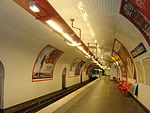Théâtre des Bouffes du Nord
Monuments and memorials in ParisTheatres in ParisTheatres in the 10th arrondissement of Paris

The Bouffes du Nord is a theatre at 37 bis, boulevard de la Chapelle, in the 10th arrondissement of Paris located near the Gare du Nord. It has been listed since 1993 as a monument historique by the French Ministry of Culture.
Excerpt from the Wikipedia article Théâtre des Bouffes du Nord (License: CC BY-SA 3.0, Authors, Images).Théâtre des Bouffes du Nord
Boulevard de la Chapelle, Paris 10th Arrondissement (Paris)
Geographical coordinates (GPS) Address Website External links Nearby Places Show on map
Geographical coordinates (GPS)
| Latitude | Longitude |
|---|---|
| N 48.884 ° | E 2.3588 ° |
Address
Bouffes du Nord
Boulevard de la Chapelle
75010 Paris, 10th Arrondissement (Paris)
Ile-de-France, France
Open on Google Maps









